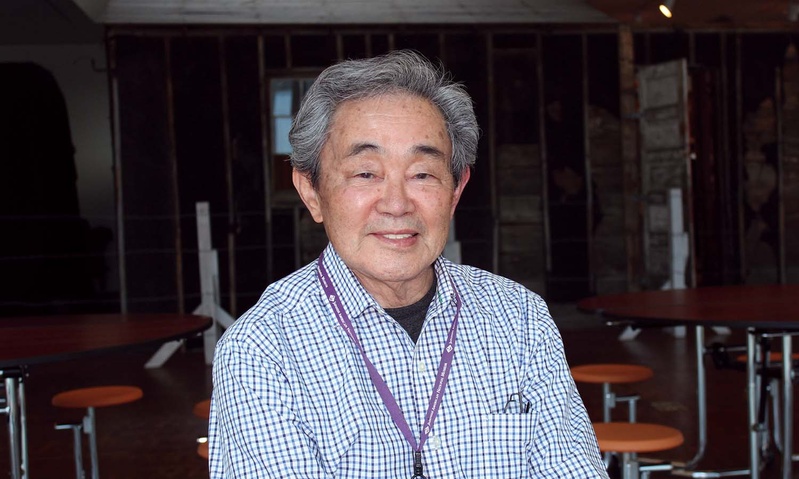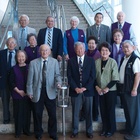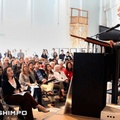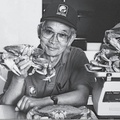James Yoshinaga was born in 1929 in downtown Los Angeles as the eldest son of a mother from Fukuoka and a father from Kagoshima. His father was from a small land owning family in a farming village, and James’ family moved to Japan temporarily when he was three years old. Upon returning to the U.S., his parents operated a Chinese restaurant in Glendale in the suburbs of Los Angeles. But, in 1937, they moved to Kagoshima again which was intended to be a temporary stay. At the time, James was in the 2nd grade at John Muir Elementary School in Glendale.
When James arrived in the farming village where his grandmother lived, he got bullied immediately. To the kids in the village, who had shaved heads and walked in clogs, American-looking James appeared peculiar with his long hair and leather shoes. It took him a while to understand the Satsuma dialect which all sounded gibberish to him at first. Since he attended a Japanese school on Saturdays back in Los Angeles, he was able to move right in to the 2nd grade. After a couple of years, James got along with everyone.
World War II broke out when he was in the 6th grade, and when he entered middle school in the following spring the entire country seemed to have been militarized. The traditional salt-and-pepper school uniforms and black caps were replaced with khaki caps, uniforms, and gaiters. He recalls that they looked almost identical to Japanese army uniforms.
Every able-bodied Japanese male was supposed to be prepared to fight when called upon. Luckily for James, the war ended before he was called to serve, but everything around him seemed to have been destroyed. His school was blown up by a group of Douglas A-20s on August 11, 1945, just 4 days before the end of World War II, with 20 classmates killed.
After graduating from Kagoshima Technical College (now Kagoshima University, Department of Engineering) in 1950, he was offered a position at a local government. However, having dual citizenship, James declined the offer since he was told that taking a job available only to Japanese nationals would be considered to have renounced his U.S. citizenship.
Around that time, the land reform law was enacted by the order of GHQ. The law required that land owners cede any land—other than the ones under their own cultivation—to tenant farmers at the prewar price. James’ parents, who owned small lands, lost all “rice tax” (rice paid as tax) from their tenants as well as farming lands, and they started thinking about moving to the U.S. again.
In June 1952, James returned to Los Angeles alone and started working as a gardener’s helper. Gardening was a very popular occupation for many Issei and Kibei-nisei who had returned from the relocation camps and were struggling to re-establish themselves.
In June 1953, about a year after his return to the U.S., James was drafted into the U.S. Army. Having gone through a similar experience in Japan while he was in middle school, he did not think that basic training was much of a pain unlike his fellow American recruits who complained. After the training, he was qualified on his bilingual ability, thanks to his Japanese proficiency. He was eventually assigned to 302nd Military Intelligence Company, 8th U.S. Army stationed in Seoul, Korea, and was honorably discharged from the army in June 1955. In September of the same year, James entered U.C. Berkeley on the GI Bill (a scholarship offered to discharged soldiers). He studied architecture and graduated in 1959.
In 1961, he was hired as an entry-level planning assistant in the Los Angeles City Planning Department. After a few assignments in different section in the department, he found himself in Central City Unit which is responsible for formulating a general plans for the Central Business District and its surrounding area that included Little Tokyo and Chinatown.
Soon he found himself caught at an impasse between his job and his community. While he had to fulfill his duties at work, as a community member, he wanted to protect Little Tokyo. As part of city planning of Los Angeles, a proposal was made to widen streets to meet regulations, and East First Street in Little Tokyo was one of the streets on the list.
Public streets in Los Angeles are classified as major-highway, secondary-highway, and local street, which are required to have the width of 100 feet, 86 feet, and 60 feet, respectively, so as to avoid congestion and maintain a smooth traffic circulation. But not all streets meet these regulations. East First Street is classified as a major highway but is only 86 feet wide. If the proposal were to affect streets in Little Tokyo, East First Street had to be widened to 100 feet between San Pedro Street and Alameda Street. This would wipe out every structure on the north side of East First Street. The community was strongly against demolition of the streetscape of Little Tokyo from the prewar days, familiar to all Japanese who could find the flavor of Japan.
James who was fluent in English and Japanese, talked twice a week with leaders of the Nikkei community, land-owners, tenants, and others and exchanged information on how they should lead the future of Little Tokyo.
Some leaders of the community, including Rev. Howard Toriumi of Union Church and Bruce Kaji, future co-founder of the Japanese American National Museum, raised their voices of concern. The pre-war buildings on the north side of East First Street have historical significance and should be preserved.
James, too, sympathized with the community and noted, “When viewed from the City’s perspective the street widening may help smooth the traffic flow in the area but would destroy the few remaining historical structures so precious to the Japanese community. We have to think of a way to preserve the buildings for the future of Little Tokyo and for the Nikkei community as well.” His supervisor, Ruben Lovret, though not Japanese, was very sympathetic to the plight of the Japanese community and supportive, allowing maximum flexibility to James’ activities.
With the advice from knowledgeable city staff, the community finally formed Little Tokyo Redevelopment Association, an entity that would negotiate with the City instead of concerned individuals and property owners. In the mid-1960s, Little Tokyo was designated a redevelopment area and was to be taken care of by the Los Angeles Community Redevelopment Agency. As a result, the plan to widen East First Street was taken back to the drawing board, and the streetscape on the north side was certified as a historically preserved district. For nearly 40 years, until his retirement in 1999, James supported community activities as a city officer.
In 2005, James began volunteering at the Japanese American National Museum with hope for the continuous growth of Little Tokyo, the community that was put back on track for redevelopment with all the hard work of Nisei. He never forgets to thank Issei who have endured all kinds of hardship to survive in America for the sake of their children and grandchildren.
Now with his bilingual skills, James supports various activities at the museum as a bilingual tour guide and as a translator.
* James Yoshinaga was interviewed by Tomomi Kanemaru and this article was written by Mia Nakaji Monnier for Voices of the Volunteers: Building Blocks of the Japanese American National Museum, a book presented by Nitto Tire and published by The Rafu Shimpo. This story has been modified slightly from the original.

Presented by
© 2016 The Rafu Shimpo








